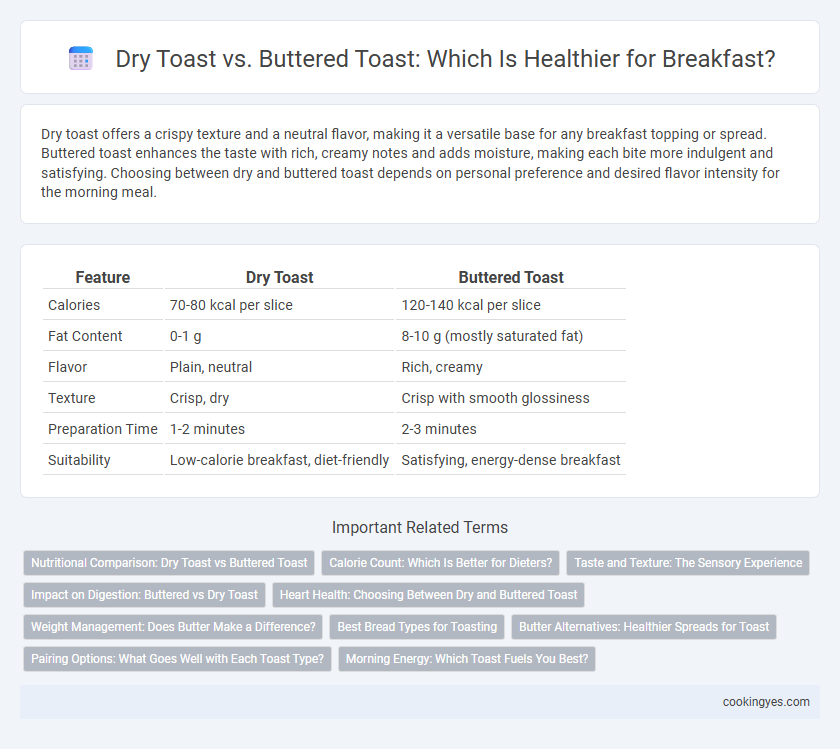Dry toast offers a crispy texture and a neutral flavor, making it a versatile base for any breakfast topping or spread. Buttered toast enhances the taste with rich, creamy notes and adds moisture, making each bite more indulgent and satisfying. Choosing between dry and buttered toast depends on personal preference and desired flavor intensity for the morning meal.
Table of Comparison
| Feature | Dry Toast | Buttered Toast |
|---|---|---|
| Calories | 70-80 kcal per slice | 120-140 kcal per slice |
| Fat Content | 0-1 g | 8-10 g (mostly saturated fat) |
| Flavor | Plain, neutral | Rich, creamy |
| Texture | Crisp, dry | Crisp with smooth glossiness |
| Preparation Time | 1-2 minutes | 2-3 minutes |
| Suitability | Low-calorie breakfast, diet-friendly | Satisfying, energy-dense breakfast |
Nutritional Comparison: Dry Toast vs Buttered Toast
Dry toast provides a low-calorie, low-fat option rich in complex carbohydrates and dietary fiber, supporting digestive health and sustained energy release. Buttered toast adds significant calories and saturated fats due to butter's content, increasing vitamin A and fat-soluble nutrient absorption but also contributing to higher cholesterol intake. Choosing between dry and buttered toast depends on dietary goals, with dry toast favoring weight management and buttered toast offering enhanced flavor and additional fat-soluble vitamins.
Calorie Count: Which Is Better for Dieters?
Dry toast typically contains around 70-80 calories per slice, making it a lower-calorie option compared to buttered toast, which can add approximately 50-100 extra calories depending on the amount of butter used. For dieters aiming to reduce calorie intake while maintaining a satisfying breakfast, dry toast offers a simpler choice with fewer fats and calories. However, pairing dry toast with low-calorie toppings like avocado or light spreads can balance taste and nutrition without significantly increasing the calorie count.
Taste and Texture: The Sensory Experience
Dry toast offers a crisp, crunchy texture with a subtle, toasted flavor that highlights the bread's natural grain. Buttered toast combines a rich, creamy layer that melts into the warm surface, adding smoothness and a slightly salty taste which enhances overall palatability. This contrast in texture and taste creates a more indulgent and satisfying sensory breakfast experience.
Impact on Digestion: Buttered vs Dry Toast
Dry toast contains less fat and fiber, which makes it easier and faster to digest, reducing the risk of gastrointestinal discomfort in sensitive individuals. Buttered toast adds healthy fats that can slow digestion, providing a more sustained energy release but potentially causing heaviness for some people. The fat content in butter also aids in the absorption of fat-soluble vitamins, enhancing nutrient uptake during breakfast.
Heart Health: Choosing Between Dry and Buttered Toast
Dry toast contains fewer calories and saturated fats compared to buttered toast, making it a better option for heart health by reducing cholesterol intake. Buttered toast, while richer in flavor and providing healthy fats if using quality butter, can contribute to higher intake of saturated fats that may increase cardiovascular risk. Opting for dry toast or using heart-healthy spreads like avocado or nut butter supports better cardiovascular outcomes in a balanced breakfast.
Weight Management: Does Butter Make a Difference?
Dry toast contains fewer calories and less fat compared to buttered toast, making it a lower-calorie option for weight management. Butter adds approximately 100 calories and 11 grams of fat per tablespoon, which can increase daily caloric intake significantly. Choosing dry toast helps reduce calorie consumption, supporting weight loss or maintenance goals more effectively.
Best Bread Types for Toasting
Sourdough, country white, and whole grain breads are the best types for toasting due to their sturdy texture that crisps well without becoming too hard or soggy. Dry toast highlights the natural, slightly nutty flavor and crunchy crust of these breads, ideal for those who prefer a simple, wholesome bite. When buttered, these breads offer a rich, creamy contrast that enhances the toasty aroma and adds moisture, making them a perfect base for additional toppings or spreads.
Butter Alternatives: Healthier Spreads for Toast
Butter alternatives like avocado, almond butter, and hummus provide healthier spreads for toast, offering essential nutrients such as healthy fats, protein, and fiber. These options help reduce saturated fat intake compared to traditional butter, supporting heart health and weight management. Incorporating plant-based spreads like nut butters and mashed avocado enhances the nutritional profile of breakfast while maintaining rich flavor and texture.
Pairing Options: What Goes Well with Each Toast Type?
Dry toast pairs well with toppings that add moisture and flavor, such as fresh avocado, fruit preserves, or creamy ricotta, providing a balanced breakfast experience. Buttered toast complements savory accompaniments like scrambled eggs, smoked salmon, or sauteed mushrooms, enhancing richness and depth. Both types serve as versatile bases, catering to sweet or savory preferences while optimizing texture and taste profiles.
Morning Energy: Which Toast Fuels You Best?
Dry toast provides a low-calorie, carbohydrate-rich option that delivers quick energy through simple starches, ideal for light morning fuel. Buttered toast combines carbohydrates with fats, offering sustained energy release and essential fatty acids that enhance satiety and cognitive function. Choosing buttered toast can better support prolonged morning activities by balancing immediate glucose spikes with slower fat metabolism.
Dry toast vs Buttered toast for breakfast Infographic

 cookingyes.com
cookingyes.com